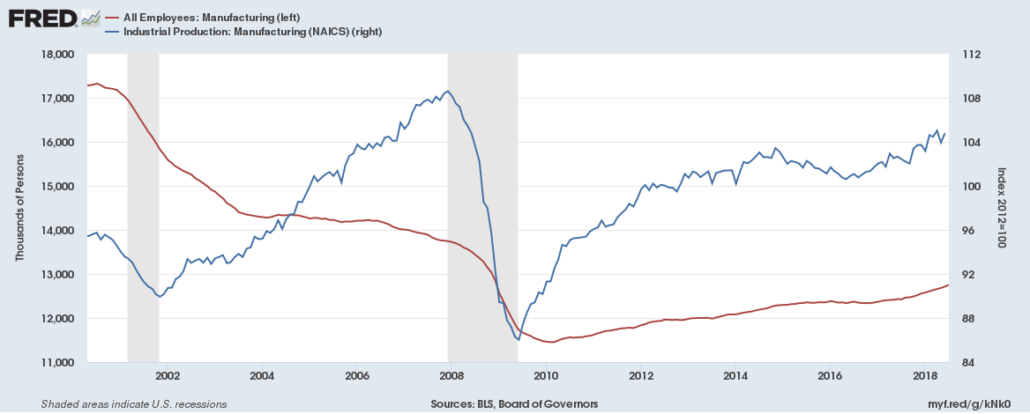Filling a Skills Gap in Manufacturing
Throughout 2018, the U.S. economy has continued to add jobs. The Jobs Report for July 2018 showed employers adding 157,000 new jobs and pegged the unemployment rate at 3.9%–which hovers around an 18-year low. This is in drastic comparison to a decade ago, when during the Great Recession the unemployment rate began its steep rise (it would ultimately top out at 10% in October 2009).
Of course, the unemployment rate is not the only indicator of a healthy economy. And recovery from the Great Recession did not progress the same for every industry. Even after the official end of the recession, many industries and unemployed workers struggled to recover. Manufacturing, in particular, has been hard hit.
The Slow Recovery of Manufacturing
Manufacturing companies were the first to feel the pain from the Great Recession with a crash in production. Next, workers experienced mass layoffs, which led to the subsequent increase in unemployment. But while manufacturing production rebounded sharply at the official end of the recession in June 2009, the lost jobs did not return as quickly.
Indeed, even with annual job growth in manufacturing reaching a 23-year high this month (327,000 from July 2017- 2018), employment within the manufacturing sector remains below pre-recession levels–and for that matter, so does manufacturing production (see chart below).
As the chart above illustrates, economic recessions impact both production and employment. However, production and employment do not necessarily rise and fall together. Advances in technology increase efficiency–production per labor hour–making it possible to do more with less. This explains why from 2002-2008 production increased while employment levels decreased. It also helps explain why manufacturing employment has struggled to recover.
The Skills Gap
Over the past two decades new technologies have increased manufacturing efficiency and production, but they have also also created a skills gap between what manufacturing needs and what the available labor pool can offer. Economic recessions have masked this problem in the past, but as manufacturing production continues to increase, technology efficiencies will be unable to compensate for a shortage of skilled labor.
According to a 2015 study by Deloitte and The Manufacturing Institute, 70% of manufacturing executives reported shortages of workers with adequate technology, computer, and technical training skills. Because of this skills gap and a predicted increase of 3.4 million manufacturing jobs by 2025 (due to baby-boomer retirements and economic growth), the study predicts there will be 2 million jobs that will go unfilled.
Filling the Skills Gap
Manufacturers have taken a number of measures to fill the existing talent gap; however, there is no guarantee that these efforts will be enough to address the forecasted labor shortage. The challenge is difficult and complex because it involves not only training existing employees to learn new skills, but also partnering with leaders in education to prepare and encourage a new generation of manufacturing workers.
Let’s look at a few ways the manufacturing industry can address talent demands in the next decade:
1. Forecast required skills on a consistent basis.
At an organizational level, skill gaps can form when leaders decide to delay investment in ongoing training programs in order to realize the short-term gain of technological efficiencies. This works well to pay off the capital costs of technology, but it also sets up a future need for new skills. When a sudden increase in production requires a round of hiring, the neglect in training will result in a shortage of labor with the required skills.
Organizations that are able to forecast the skills required for future growth will be better positioned to develop a talent management program that maintains a continuous supply of skilled labor.
2. Invest in training for new and emerging roles (require it when necessary).
In order to provide a positive work environment, it’s always a good idea to give employees options as it relates to professional development. Empowering employees to take ownership of their career trajectory is an important component of employee happiness. However, if it becomes apparent (after a required skills forecast) that a particular role will soon become obsolete, then employers can avoid a labor shortage, costly hiring, and poor employee morale by proactively requiring training for new or emerging roles.
3. Open factory doors to the community and engage it.
Manufacturing has suffered from an image problem. The stability of a career in manufacturing has been in question. The benefits have been overlooked. The complete nature of the job is misunderstood. Manufacturers can set the record straight by engaging local communities–neighborhoods, government, and institutions–and inviting them to learn what a manufacturing career is and what it’s not.
Efforts to promote the benefits and dispel the myths of a career in manufacturing should go beyond print, digital, television, and radio. To reach a new generation of manufacturing talent and really spark an interest, employers must be willing to show them the reality.
4. Establish scholarship and internship programs beginning at the middle school level.
Children begin thinking and dreaming about “what I’m going to be when I grow up” at a young age. Through middle school, those thoughts and dreams become more refined as they receive more information from parents, teachers, peers, and the media they consume. At this point, most of the information sources that hold a child’s attention are likely misinformed at best, biased at worst.
Just like in point #3, employers must be willing to get in front of young people before they develop a flawed understanding of a manufacturing career. Scholarship and internship programs–some could span several years–that engage students early and provide them with a true understanding, hands-on experience, and a clear path to a rewarding career will go a long way toward fighting long-held misperceptions.
5. Promote the people behind the products.
Too often it’s the products–features, benefits, and functionality– that are promoted. There is rarely a reference to how products are made or who makes them. This is not to say that every ad or commercial should have a story behind how the product is made. But telling that story can influence the minds of both consumers and individuals who are still deciding on a career path.
When manufacturers have the opportunity to present their business to a larger audience, whether through product advertisement, conventions, trade shows, community events, or even small meetings with public officials, it’s a great opportunity to promote the reality of a career in manufacturing. Lead with people not the product.
In the Year 2025
The U.S. manufacturing industry is not waiting for the year 2025 and a deficit of 2 million skilled employees. Many of the points above are already being implemented in one form or another. Other actions are being taken as well. Unfortunately, decades of industry misperception is not easily overcome. So it’s yet to be seen whether or not these actions will be enough to fill the forecasted skills gap.
And of course there’s always the huge factor of the economy. The strength of the American dollar, trade tariffs, trade agreements, and a host of other variables beyond the scope of this post will all impact manufacturing production and the demand for manufacturing labor. But ultimately, whether the 2025 forecast holds or not, the manufacturing industry must ensure that its future workforce is adequately trained and available to meet the demands of a global economy.
ExactHire provides hiring software to help manufacturing companies quickly recruit, hire, and onboard new employees. To lear more about how our solutions create new efficiencies for growing companies, contact us today.




